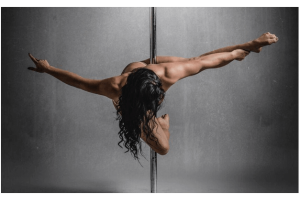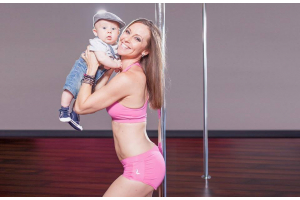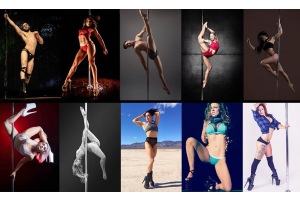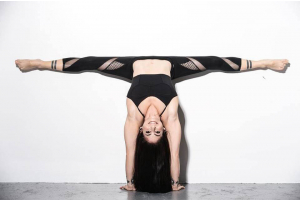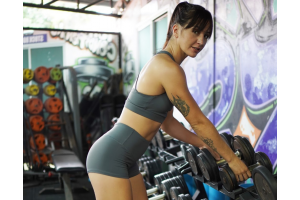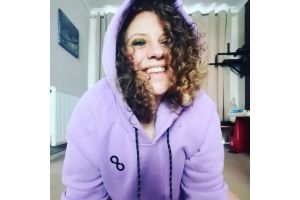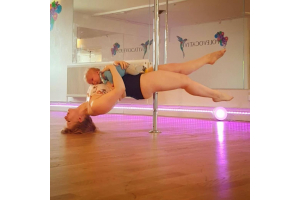The Circus Doc Interview | Aerial Anatomy | Episode #017
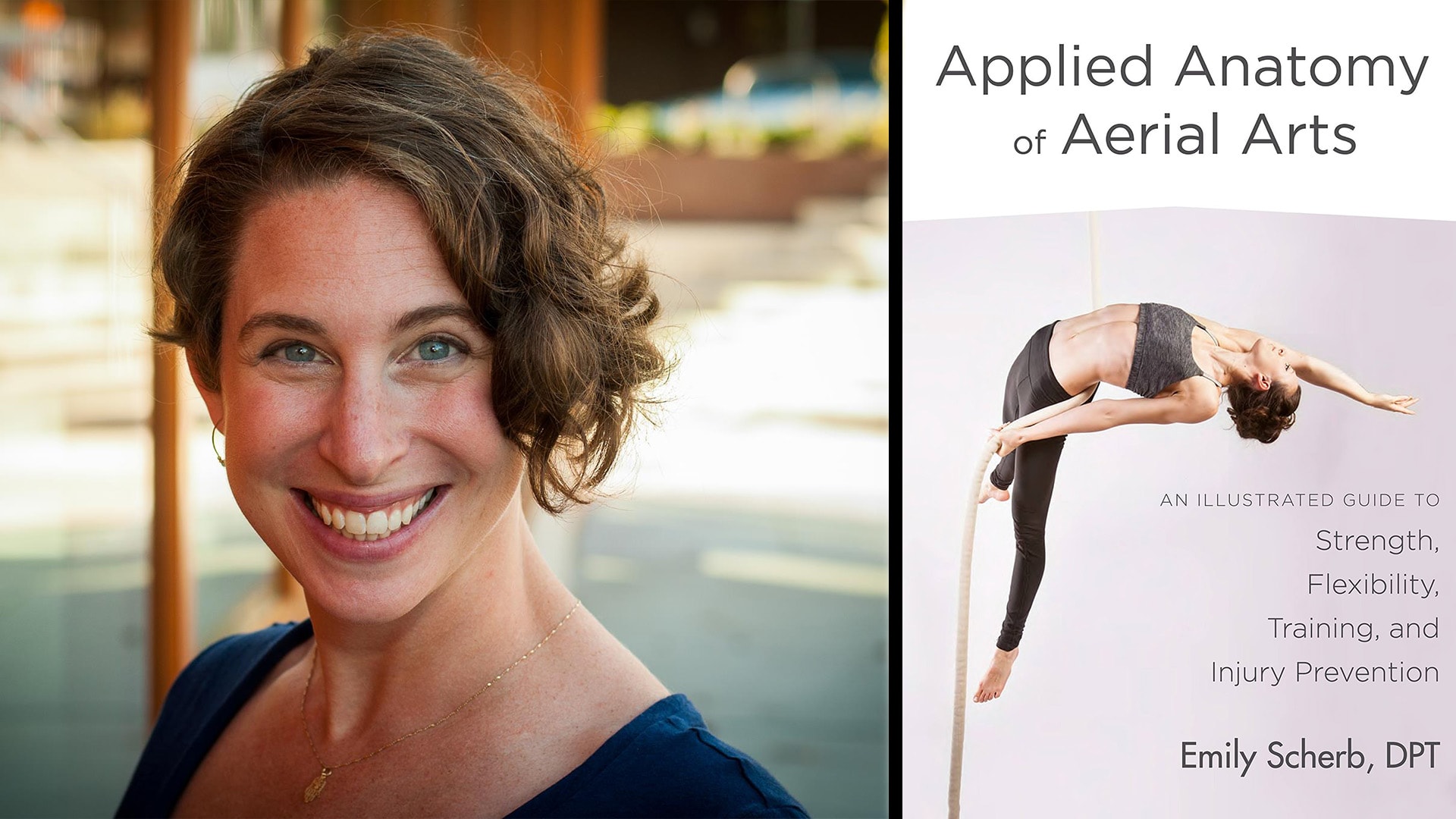
The 17th Episode of the OTP Podcast features Dr. Emily Scherb, also known as The Circus Doc. She is a physical therapist, instructor and a practising aerialist for over twenty-five years
She works with professional and pre-professional circus artists. She is the Resident Physical Therapist at the School of Acrobatics and New Circus Arts and for the contemporary circus company Acrobatic Conundrum.
She has just released a new Book called Applied Anatomy of Aerial Arts and I loved having the opportunity to sit down and drill her with questions –hope it’s the first of many!
Hit play above or watch or read the transcript below.
Sarah: Welcome Emily. Thank you so much for doing my podcast.
Emily: Thank you so much for having me.
Sarah: Also known as The Circus Doc, which we're going to be linking to all of your social media stuff and website and all that stuff so if people haven't heard of you they can obviously find out about you there. Thank you for giving up your morning, it's 9:00 am where you are?
Emily: About 9:00 am, yeah.
Sarah: About 5:00 pm where I am, so we're a little bit spread out but we've managed to make it work which is fantastic. I've posted in my off the pole community group that I was going to be interviewing you and got lots of questions from them. So I'm going to be touching on some of those in a bit, but I'd like to start off with hearing about your book that you've got coming out, or has it already been released?
Emily: It is about to come out next week.
Sarah: Ah, fantastic. A little bit about your book, what's coming out and what lead you to write it.
Emily: Absolutely. The book is called The Applied Anatomy of Aerial Arts. I've got my copies already.
Sarah: Ah, so shiny.
Emily: But they're not quite out for the general public yet. It's an anatomy book based on how our bodies actually work in the air. It is talking about the basics of anatomy, how they work for everybody and then how that specifically works when we change how gravity works on our body and are hanging from our hands instead of standing on our feet.
Sarah: I'm so excited about this book. I know there's so many people that are going to be completely geeking out that this book's coming out because it's so hard, you want to do research, you want to find about how to look after your body and then you look at all the anatomy pictures and the videos out there and everyone is just stood on the floor and it doesn't work the same, it completely changes it when we're flipping around in the air. This is so exciting. And you've got a huge background in this area. What came first, the physical therapy or the aerial?
Emily: Most definitely the aerial. I started doing aerial back in about 1991 or 2, so I've been doing it for a very, very long time. I started off as a gymnast and found my way into circus as a relatively young youngster. It really was just, oh, instead of having to compete and having to perform that way, instead I get to perform, then people clap. This is fun. And there was similar challenges on the body and similar demands of a training schedule to keep myself in shape to do it and so I really just fell in love and started doing it back then, kept doing it, started teaching and have been teaching ever since my late teen years.
Emily: I've just continued applying all of that knowledge I learned as a teacher and as a performer to what I learned in physical therapy school. It's kind of amazing how much looking at movement and watching other peoples' bodies work and understanding how your body works and then applying the science, you really understand it at a much different level. It's been fun now as a clinician to be able to combine the two and be able to give back to the community and treat all my lovely aerial circus, pole, fun, wonderful humans and to learn so much more about how even other peoples' bodies works and not just mine and applying all the science behind it.
Sarah: Yeah, that's fantastic. It's such an interesting perspective from someone who's come from aerial to then go so deep into the physical therapy side of it to be able to try and relay that back because pole and aerial, as a sport, art, dance form, however, you want to describe it-
Emily: Whatever you want to call it, yeah.
Sarah: I think it's all of those things and more. It's relatively new for the general public to be taking it on. From a gymnastic point of view or a circus point of view obviously, it's been around for many, many years longer but to take the general public and then put them into that kind of activity, it can be hugely dangerous as well as hugely beneficial. We're walking this tightrope of danger and benefit. And the long-term impact on peoples' bodies, I think is only really starting to come out now. Are there any real patterns that you see from treating people that you've taught or that you see other people teaching that you see constantly crop up time and time again?
Emily: Absolutely.
Sarah: Probably going to say shoulders, something like that…
Emily: What is that? No. Shoulders?
Sarah: I know, I'm breaking some new ground here.
Emily: Yeah, shoulders. Shoulders, shoulders, shoulders. And I love them but they are such a complex joint and we use them often at the end range of their mobility, of a very mobile joint and then we ask them to be really stable, support our whole body weight and then turn us upside down. We're asking a lot of a relatively complex joint, one of the most mobile joints in the body and a relatively unresearched joint because of that. The shoulder is a really, really complex, mobile joint, like I've said, and because of that it's hard to break it down and put electrodes on the different muscles. It's hard to fully understand what's working where and there's so many human variations about where the muscles can attach that it's sometimes hard to generalise.
Emily: Unlike the knee, which is a nice simple joint. It goes back and forth, the shoulder just doesn't have the research behind it. Not only are we asking a lot of these joints, we know less about them than a lot of the other joints in the body.
Sarah: That's promising…Basically, people are staying away from them. They're like, that's just going to be too much work. I'm just going to leave that one. I'm going to go for knees.
Emily: Yeah, no, we're trying to learn more but it's definitely why it's slower to learn about it.
Sarah: I definitely feel like the more I've tried to learn about the body, the less I feel like I know. I know that's kind of a bit, not necessarily making sense…
Emily: It's wonderful.
Sarah: I'm more and more interested in it, but I feel like-
Emily: You need to get the questions. You're truly learning.
Sarah: I feel like I fix one little bit or I find out about one little bit and then that opens up about five more doorways and to be like, yeah, but this now and then we have to look at them and then you're like, now I've got to go off in this direction. It can feel quite overwhelming. Is there any kind of solid tip that you would say to someone who's maybe just starting to think about looking into their body and how to ... buy your book, obviously?
Emily: Well first, buy my book. I really think that the first thing to start doing is to, if you're in the pole community, start talking to your coaches and ask them what they think should be working. And then just seeing in your own body, can I feel that working? Can I connect to the different muscles in my body, I'm always amazed. Some people have no problem with that. They're like, this is my biceps, I will fire my biceps and other people are like, I can bend my arm, but I don't really know that's my biceps.
Emily: The first thing to do is try to feel your own muscles in your own body working so you can get acquainted with that. And then, try to look at anatomy texts, looking at images or there's some great anatomy videos online where you can see the muscles working. And that's really fun 'cause you can go, okay, I can see that, can I feel that? I think the key is to really start to feel in your own body, especially if you're exploring it as a performing artist because if you can't feel it in your own body, then you can't make the changes that you're looking for. Find it in yourself, compare it to what you think you should be feeling, try to make those correlations and connections.
Sarah: How much do you feel like your own knowledge and study ties in with your own training? How much do you use that knowledge in your everyday training?
Emily: Oh my gosh. It is actually kind of embarrassing. Because I did start so young and the knowledge was even less than, I know you touched on it before of how much more of the general public is getting involved. Recreational aerial arts, in general, have just exploded. In the last decade, the number of schools, the number of people teaching, the number of people learning has just gone wild and that's really increased the knowledge that we have around it. But that means when I started, there was so little, so little knowledge and now I go back into the studio and just try to fix all the problems that I developed over the years.
Sarah: I was going to say, is there anything that you could tell yourself back then that you know now-
Emily: Oh my god, so much, so much. I look at the old actual film photos because I didn't have a digital camera and I'm like, oh Emily, when you're hanging from your knees, open your hips, squeeze your butt, use your core. Hanging from my arms, they've gone down now but, 'cause I don't train as much as I used to unfortunately, but my lats were this wide and I used them for everything and just torqued the heck out of my shoulders. You want to use them when you turn upside down, but you don't need to use them all the time at full blast like I was doing.
Emily: There are things I am constantly still working on to this day 'cause when my knowledge increased, my training time decreased and now it's harder to keep those things all in check. But I could spend an entire workout just correcting a basic inversion or a basic knee hang.
Sarah: I think the beauty is in the details when you start to get really into it. And actually just getting into the movement becomes the least important thing, it's how you're getting in, how you're getting out of it and what you're feeling when you're in there and then comboing it and endurance of holding it and doing it on both sides and all the rest of it. I think there's a big push nowadays for people to try and get quantity over quality in their tricks, which is an industry problem and it's not any one person's fault, I'm not trying to blame one person but I feel that students have a lot of pressure to be like next, next, next, next. Whereas-
Emily: That's exciting.
Sarah: Back in the day, there just wasn't the same number of tricks. You could spend a huge amount of time on a leg hang and that would be it because that was all there was really, just leg hang and a superman. You could win a competition, it was great. People were amazed with your knee holds. Now they-
Emily: There's a lot of pressure. I think it's a lot harder to enter the industry now than it was before. There's so much more pressure, there's ... Instagram is great, it's wonderful, it's a great way to share but it's a lot of pressure when you're looking at everyone else and seeing, oh, that person's doing that and that person's doing that, but one of the biggest joys of my nerdy life is going in and having that very frustrating but very meditative practice of just working one thing and trying to make it perfect.
Sarah: Yes, I'm exactly the same. I would much prefer to do an hour, hour and a half on one thing and just really get the grips of it rather than lots of little things, but it is also a problem. And I'm part of the problem, I post on Instagram all the time. You also only really post what you're really happy with, which is normally the finished product so people don't see the hours that have come before that, of the warm-ups and the mobility and the figuring it all out and then the rehab afterwards, when you've done it too many times 'cause you pushed it too far.
Emily: I did the same thing too many times in a row. There are problems with that too.
Sarah: Yes, yes, exactly. Is there any kind of ... I know one of the questions I did get from the group that did kind of segue into that, Sara or Sarah, with an h or without an h, please could you ask about training regimes, what gives an artist or let's say an amateur juggling a full time job the optimal chance to develop well as an artist and safely? If you're trying to fit in training plus regular life, I know there's no magical number of you should train this much, but is there any way you recommend how to balance it out?
Emily: One of the biggest things, it really is a balance. I have two things to say on the matter is consistency and rest. Consistency is probably the hardest thing for most adults that have a full-time job and train. I know it is for me. Training a minimum of three times a week to maintain what you've got and probably three to four times a week to make true gains is generally a good rule. But the consistency thing is the real key thing. You need to be training on a regular basis. You need to have a plan and a goal. Making a training plan, creating your goal list and how you want to get there. If your goal is a certain skill, what kind of strength do you need to get there? Are you doing strength training in addition to just pole?
Emily: A lot of aerial is interesting because we tend to go up, do one or two skills, come back down, rest, talk to our friends, wait for somebody else in class to do their thing. Working on cardio and connecting things is a really important component that people sometimes leave out. But for just pole and just not even worrying about the rest of the training regime, trying to train pole three times a week can really help keep the consistency level of load on your tissues, load on your muscles and tendons so that they are not going to break down and get injured. And then trying to push that a little bit and you can probably make some gains in strength.
Emily: The hard thing is when you go away and take a break, coming back in without getting injured, you need to give your body the chance to readjust, to go back a level as well. Respecting when you don't have the chance to make those gains. But the key really is, train, train consistently and don't have big fluctuations in your training. If you're taking a huge break, be careful when you come back. If you're ramping up for a competition, make sure you make slow, incremental changes. Don't just all of a sudden the week before the comp say I'm going to go in everyday and train really hard and add that new skill.
Sarah: Yep.
Emily: 'Cause that's when things break down and you get hurt. If you have a competition coming up in three months out, you want to peak your training ramp two to three weeks before that competition so that you can cruise on into it, feel really comfortable with your skills and your body is well rested. It's one of the things I see a lot here in my practice is people getting injured right before shows or right before competitions because they're trying to add that one new move or they've really ramped up their intensity.
Emily: When you're training, make sure any changes are incremental. That you give your body the time to adjust to the load. The key is warm up well, do your cardio, add some strength training, keep your mobility so your muscles are all balanced and train consistently. It's the things in general that people say a lot but they're true.
Sarah: I think if it ain't broke, don't fix it. And sometimes we all need a reminding of stuff that we already know but to have someone with your background say it, no, no, this is gonna help, this is really what the professionals recommend I think is very, very useful because we can all think it but it's nice to have the backup of someone saying, no, no this is a great baseline. Of course, listen to your body. If three times is too much, blah, blah, blah. Everyone's going to be slightly different but having that baseline of something to work from I think is really, really helpful for people. For competitions and shows people naturally just ramp up the training.
Emily: It's so exciting.
Sarah: Yeah, yes, exactly. And it's great to get in it and it's a great push to get yourself in and train if you have something like that, but I definitely feel it if I've got the repetitive strain type injuries start creeping in, you start getting like, my shoulder's just achy all the day now rather than just after I train.
Emily: That's time to take a back up a little bit, take some rest, do some self care.
Sarah: I know a lot of these questions are going to be for the individual but is there a point because a lot of the time I think pole dancers and aerialists, we get used to being in pain quite often. Is there a recommended time when you should go see a professional or is there cases where people should be taking more responsibility and more self-care? Or is it going to be based on a case by case basis?
Emily: Certainly a little bit case by case basis but there are some general guidelines. The first is to recognise the difference between soreness and pain. If you're training and you have soreness immediately, chances are it's more likely to be some kind of tissue damage. If you have soreness after 24 hours and it's muscle and in the middle of the muscle belly, that's more like delayed onset muscle soreness. The more traditional, I worked that muscle really hard. That should go away within 72 hours. If it doesn't go away, I do have that immediate onset of soreness or pain, that's when you want to get it checked out.
Emily: Certainly if you have something that happens immediately and you have sharp pain and you cannot use it, you're going to want to get that checked out pretty quickly. But i think really what you're talking about is that, oh, my shoulder hurts and it's been hurting for a while, is this a good thing, bad thing? Am I getting stronger or is my shoulder falling apart.
Sarah: Yeah.
Emily: Is it slowly coming off? Anything that doesn't go away or is at least starting to get better after a week or so, it's best to get checked out. If it's getting better, great, keep doing what you're doing but you might want to back down a little bit. And certainly after two weeks, if it's getting worse or not going away, definitely get it looked at. One of the best things you can do is, for shoulders, 'cause of course shoulders are everything, is to really balance what you're doing. If you're doing a lot of pulling, if you're doing a lot of inverting and you're constantly pulling your arms towards your body, it's really great to work some things that are pushing, and to going away from your body, whether that's through weights or through other movement practices. Sometimes that's enough to balance it out. If the basic things of getting stronger and balancing your muscles don't help, certainly go see someone. We're all here to help you answer questions, so find someone great and hold onto them forever.
Sarah: I think that's also part of what people get frustrated with. We see a lot on the community group, a lot of people are going in there for diagnosis advice and a lot people go back and say, go see a professional but then a lot of people are like, who, who do I go see because my physio isn't used to dealing with someone who's in aerial or my doctor hasn't got a clue what I'm saying and I tried to show him a video and he got uncomfortable.
Emily: Just stop.
Sarah: Yeah, or to stop and rest. Which is know is fine, but a lot of these girls then won't ... girls, boys, women, whatever, everyone just wants to keep training. Humans.
Emily: And it's easier if someone says, okay, I fully understand what you do, time to take a rest or I fully understand what you do, don't do these three things but you can do these three things. It is ideal if you can find someone who gets you. In the US I do have a list on my website of PTs that have reached out and said they love treating aerialists.
Sarah: That's helpful.
Emily: I don't have an international list right now, but I'm trying to grow it. So hopefully soon we'll have more and more as our community grows. There's certainly, as it's all exploded in the US now people, over the last decade, that have gotten involved in it are now going back to school and getting their degree. So there's going to be more and more and more of us over the next three to five years. I think there's really going to be an explosion so hopefully the community will start seeing the benefits. But ask the other people in your studio. Ask your coaches, see who they see. Try to get information from your community or reach out to professionals that may not be in your community but you know are a part of it and might be able to offer you advice for where you are locally. Or at least know who you should be asking. It's hard. It's putting a lot of burden on the performing artist, but your body is your instrument and your tool, you have to take care of it.
Sarah: Are there any things especially around shoulders, I know we've got a lot of questions about shoulders. One, how to strengthen them and stabilise them but also how to increase flexibility whilst maintaining that strength and that stability, which we're asking a huge amount as we said earlier. Is there anything that people should be at least starting off with so they don't get too overwhelmed so that they don't have to wait until they get an injury or they're in pain before they go see someone.
Emily: Yes, absolutely. There's a lot of pre-hab that you can do to keep your body safe. Understanding the shoulder is helpful to you. The way the shoulder works is you have to think of it as just kind of floating on the body. The only place the shoulder is attached by an actual joint to the torso is at your clavicle, so right in the front, where your collarbone meets your ribcage. Other than that, it's all attached with muscle. You really have to keep everybody really happy and balanced and the thing is, in aerial arts, what we do is the same thing over and over again and so we get certain groups of muscles super strong and other muscles not so much.
Emily: We really need to make sure that first of all our technique is great. Work on your technique, work with other people. Don't just train on your own. At least have a training partner or a good coach that you trust and hopefully your technique is great. First perfect what you're actually doing, but then learn what the things are that you need to be doing to balance that out.
Emily: Again, in aerial we do a tonne of pulling, you've got to do some pushing to balance that out. I always say to people, hey, just do some handstands 'cause that's really fun and way more fun than pushing weights up over your head versus having to do pulling all the time.
Emily: And the other thing is our rotator cuffs are the things that hold our arm to our shoulder blade. And when I say rotator cuff, the rotator cuff is not one muscle, it's a muscle group. A little more than half of them do external rotation, or rotating the arm out to the side and then we have a few of them that rotate the arm in towards the body. And we need to keep them all strong. We're really good as humans as bringing our arms together in the front and we use our internal rotators and our pecs to do that grip and so they're pretty big muscles going on. And our lats help with that too, they're internal rotators as well.
Emily: And then our external rotators are these tiny little muscles that when our arms are straight up over our head we're using the most and so those need to be so, so very strong in anyone who hangs from your arms. External rotator cuff work, training those muscles to get them super strong, working on those rotator cuff exercises. The one I see most commonly is the one with the theraband attached or you're holding it in your hand and you're rotating your arm out to the side. Even doing that, make sure your should is set really well. That you're in a good position. That you're actually using your rotator cuff. That you're not squeezing your arm in next to your body or rotating your torso to get that motion instead of actually using the rotator cuff
Emily: But getting that rotator cuff strong and keeping it strong and making sure that it's not the first thing to give out on your body when you're training 'cause if that goes, you start running into problems of the shoulder joint not working well. You've got to make sure the shoulder joint itself is working well and then all the muscles around the shoulder blade are playing nice and balanced.
Emily: Strength is a huge component but the other part that you're talking about in the mobility, it's amazing how much more mobility you get when your muscles are balanced. If you balance your pulling and your pushing, your external and your internal rotation and all the muscles are happy and working together, your arm is free to move in all the ranges of motion that it has available to it and you don't have to force it nearly as much. When I talk about mobility work, I would like to talk about strengthening it in range and really working on getting strong there so that you have the control and your body let's the arm move where it needs to go. I like things like, laying on your stomach with your arm up overhead, so you're at very end range of the shoulder and then turning the palm up, so you're now engaging that rotator cuff and trying to lift your arm up off the ground. It is so hard.
Sarah: Yes. Is that the YTW exercises? Is that the-
Emily: It's a variation on that. So it's all the way up overhead. I treat it, even more, to have palm up because we need more range of motion than the average human.
Sarah: Yeah, I was going to say I've only ever really done it a thumb up. I've not taken it to there.
Emily: Try palm up.
Sarah: But even there you know it's going to be really bad.
Emily: Oh, it's so hard.
Sarah: It's going to be dirty, dirty but good.
Emily: It hurts so bad. And if that's too hard, you can do it on your hands and knees so you have a bigger range of motion to work from or pile up over some pillows so you've got a little bit more to work with. But if you can lift your arm off the ground with your palm up laying on your stomach, your shoulder mobility is going to be awesome.
Sarah: Gold star for you.
Emily: Gold star.
Sarah: They will be very impressed. The people in the gym, if you were doing it there, would probably just ... what is she doing, she's lying on the floor, but everyone else-
Emily: She's lying on the floor, grunting, and can't lift her arm. And this guy's got like 40 pounds of bad form bicep curls and-
Sarah: But I guarantee he will definitely won't be able to lift his arm off the floor
Emily: He would not be able to do it.
Sarah: Not a chance. It's always the small, non-interesting, doesn't look like you're doing anything exercises which-
Emily: Oh, they're brutal.
Sarah: You'll be sweating, sweating instantly. And they're the ones that are most helpful. If you were going to say, again, because I've got a number in my head but you're a professional so I want to ask you. If you're saying to someone, get in there, start doing some rotator cuff strengthening to help stabilise your shoulder, how many times a week? What do they start off with?
Sarah: Everyone's going to ask, they'll be like, how many times should I do this a week? Um, three, I don't know.
Emily: But really, the body does really well with about every other day. Giving things a rest day, but still getting things stronger. Three to four times a week, it's the magic number of giving the body a little bit of a break but still getting the training going. Depending on what your training is like, you can do it after your training to ... you can do a light rotator cuff warm up or shoulder strengthening warm up, just to get your arms going-
Sarah: To get them firing, yeah.
Emily: Get them firing, get the patterns going the way you want and then you can do stuff to fatigue after training. If your training practice didn't fatigue your muscles, you're burning them out so they can keep getting stronger. It's a nice adjunct to your actual training process. Or if you're doing it on separate days, make sure you're not so tired when you go into the studio that you can't work properly. Fatigue has not been studied yet with aerial but I say yeah, 'cause hopefully in the future we will have all these beautiful researchers going around and studying it for us but it would be really interesting to see how the muscles fatigue before and after training and what that looks like and how our other training effects it.
Sarah: I have a mastiff trying to get in shot. Go away, lie down. Go over there. He's like, almost dinnertime ... no, not yet, in a bit, I said dinner, now he's ready. His ears have come up [crosstalk 00:32:30]. Anyway, segway into, I know you said earlier, we're very good at pulling inwards and I know a lot of peoples' every day, day to day life, that requires a lot of that as well, we're driving, we're on our phones, computers, all of that stuff and that ties into, I'm really interested in posture and how that affects a lot of students. They'll come in after being in one position for eight hours of the day and then for one hour of the day, that training, they want to go in completely the opposite direction. That can super challenge. What have you done today? You've just sat in one position with your arms internally rotated and now you're asking them to externally rotate and be comfortable there.
Emily: Come all the way back here.
Sarah: Yeah, why isn't this feeling good or working? Is there, the specific question was from, I'm trying to get people's names in as well, so Crystal, she said, do you have any tips on years of bad posture 'cause she's getting really frustrated with having to undo years of bad posture. We find out that we need good posture for aerial and it's a long road back.
Emily: It goes way back to what we were talking about before when you had asked me of, how do you start if you're getting interested in anatomy. First thing you have to change if you have what you think is bad posture is, can you find the muscles that you should be working? As a side note, there is no bad posture as long as you can change it.
Sarah: Yes.
Emily: You can sit however you want all day long, that's fine, as long as you can also sit like this and you can also put your arms back over your head. But if you're stuck in that curled forward posture, that's when you want to work on strengthening the opposite muscles and the opposite muscles tend to be the muscles behind the shoulder blades in the back 'cause as I said before, the shoulder blades float on the body and if your arms are always in front of you and you're always doing things in front of you, those pecs get really strong, they tend to pull the shoulder blades forward, we get good at stabilising with the front of our body and we go to move our arms and our back muscles are not doing anything. We've got this hunched over thing, where our upper trapezius of the neck and the pec are doing all the scapular stabilisation and we really need to move into the back muscles, getting into the middle and lower trapezius, into the serratus, now I'm just name dropping.
Sarah: That's fine. name drop all you want!
Emily: Name dropping my friends and muscles. But we really need to connect to the muscles between the shoulder blades and around the shoulder blades. First, waking those up and connecting to them, and then finding ways to strengthen them. For people who have that stuck, persistent bad posture, often stretching is really hard for them because they can't stretch pec, they can't stretch that shoulder open, instead, they end up stretching the joint and putting a lot of torque on the shoulders. Really being aware of your body first, or having someone who's there to help you, a coach, a physio, someone who's there to watch to make sure you're doing the right thing. But strengthening in the back is what helps open up that chest and get you strong and stable.
Emily: Pull can be great for that if your technique is perfect, or it can feed right into that if you really have your hands in front of you and your shoulders forward to stabilise. I want everyone to think when they're grabbing the pole if they're grabbing the pole and pulling it to their sternum and so their chest has to open to get there. If your shoulders are forward, it's going to feel really claustrophobic and if your shoulders are open it'll help. It's really opening that chest and bringing the pole into you.
Emily: And then, of course, I have some favourite exercises, maybe Sarah after this we'll have to get together and I'll post some videos or something so people can see the few things I'm talking about.
Sarah: That would be fantastic. Definitely.
Emily: I have a favourite one with hands up, back to the wall one that is my favourite undo your workday posture exercise. It's hard to describe but it's one people have seen before but I have a little twist on it where I make people pull their elbows forward so they're really connecting into their serratus and their rotator cuff to help the shoulder blade motion.
Sarah: Nice, I think it's good if people even have just ... even if you just start off with one or two things that you do at the end of your workday, rather than thinking right now I've got to go and do an hours worth of stretching to go and do all that I feel like, I'm just going to do five, ten minutes doing a couple of things and it doesn't become overwhelming and actually you see massive increases in ... big gains from little, little steps. I'd much prefer that kind of ... if people can take something like that away from it, even just one thing that you change a day can actually make a big difference.
Emily: Yeah, even if you take multiple little breaks throughout your workday and think, once you come into awareness of those back muscles, can I fire them, can I open things up? Let me hold this, while I go back to work but ignore it, but go back to typing and doing your email and then, oh, the phone rings, okay, that's my cue 'cause I've fallen out of that posture to pull back up again and see and use your workday as your strengthening. There's no reason why you can't start to work those muscles.
Sarah: Use this podcast. Sit up now everybody.
Emily: Use this podcast. Sit up, sit up now. Engage your back muscles.
Sarah: See if you can hold it until the end of the podcast. I guarantee as soon as you start doing that posture, everyone would have sat up anyway like 'I'm fine withh my posture!'
Emily: But it's amazing because when you're doing that you're using those stiff, tight muscles as your weights. You're using the opposite muscles to pull against them and you're lifting those heavy pecs. You can use your body as your own little weight system at work.
Sarah: Especially if you're in a train station or an airport, you start getting a bit judgy of people.
Emily: Oh yeah.
Sarah: You start people watching and you're like, her knees are turning in and she's rounding her back.
Emily: You're like, oh, that looks like it's gotta hurt.
Sarah: She doesn't look like she's been thinking about her posture today.
Emily: But again, they're travelling. Maybe they're had a bad day, that's not their normal posture. They can move in and out of it. They have no pain.
Sarah: It's my fun airport game, let me be. It's fine. I've got a couple of questions. I could honestly natter along to you all day, but we've definitely had loads of questions about hypermobility, especially elbows and shoulders. Any tips on specifically how to work with them?
Emily: Anyone who's hypermobile, you guys are amazing. We certainly have our share of it in the aerial world. I feel like it definitely attracts because the lines are so beautiful and it's so much fun and it really uses it. But you do have to work harder. Well done. Way to get where you are but it's always a little bit extra work. The key to hypermobility is train a lot and train in mid-range so that you're aware.
Emily: One of the biggest problems of hypermobility is not knowing where straight is. For a lot of people who are pretty stiff, it's very easy, it's when my arm stops moving, that's straight. But for hypermobility, you need to find straight and strengthen there and balance those muscles so they can stabilise your joint so you're not relying on your joint structure or your ligaments to actually hold you together. Finding mid-range, maybe doing some plank positions and watching your elbows and holding them there, seeing if you can hold it and strengthen there and then playing with it on the pole. But it is a lot more work and it takes a little bit longer for hypermobile people generally to gain that strength and that control because they don't have the same cues of, I just stop moving there that normals, I'm air quoting right now, of normals do. Working in mid-range, what feels like mid-range to you but is actually straight and gaining the strength there and making it a priority.
Sarah: That's very good advice. And if you want longevity, it's worth doing the time at the beginning or at least, even when you find out about it to pull it back and that's actually going to make you a lot longer in the industry than just, oh well, it feels fine now, I don't feel any pain now but down the line you're just going to end up having to cut yourself off from it and that's just going to make you sad because you can't pole!
Emily: No, no, we can't, if we're not in the air, why? Then you can use that beautiful line and that beautiful extension, that hypermobility when you want to but you're not a slave to it. Same thing with the posture, it's the same idea. If you're stuck at that end range and you're stuck in that hypermobility, it's not nearly as useful to you as if you have choices about where your body is.
Sarah: Yep, that's really good advice. And this might tie in, the last question I want to hit to you is from Louise Young, and she had comments underneath with people agreeing that this was a good question they'd like to know. Have you ever worked with anyone with Dyspraxia and if so, did you find a way to help them understand their movement when doing aerial, so this might tie in with the whole learning about their body and anatomy and this kind of thing, buy your book. Segway.
Emily: You're so good.
Sarah: I'm not getting paid for this podcast by the way. I'm very excited for your book though. Have you come across it? Do you have any hints and tips for getting people more aware of their body? Especially when upside down. I think it's a very common problem that when you're upside down, it's like left is right, right is left, a foot is an arm, no one has a clue.
Emily: Right. There are a couple of different types of dsypraxias, so it depends a little bit, but in general, breaking things down into small chunks. Learning things piece by piece and then trying to put the pieces together, one or two at a time. Learning left and right when you're upside down, I love different coloured socks, which I know is really hard with pole but ... or maybe getting, kids make friendship bracelets, getting some of that soft cotton string. Tie different colours on your ankles and wrists so it can be, red hand, blue foot, so you're not having to figure that out all the time. That works really well too if you're videoing yourself for everybody. All these things work for everybody, it's just you have to spend a little more time with them if you have other things going on. But that works great for video because you can be like, what foot went where? Oh, the blue one.
Sarah: It was my blue one, yeah. We both went for blue, huh
Emily: And then you're like, which one's the blue one. You look down, you're like, oh, yeah that one.
Sarah: That one, that's the one.
Emily: It's gotta be the blue one. It's always the blue one, that rogue blue foot.
Sarah: It's always that blue foot, typical.
Emily: Yeah.
Sarah: I use the slap and tickle method, which is not as nice I don't think. Like you slap the thing or you tickle or scratch which is maybe not as good. I think probably the red-
Emily: It is if you can't see it. If you can't see it, it's helpful. Like this one, poke, poke, poke, poke, poke.
Sarah: Yeah, the one that I'm tapping or whatever.
Emily: Yeah, but it helps, also having that video, even if you aren't, as long as your school allows video and people don't have other things against it. I know some schools don't want that posted or allow for it but if you have that for your own practice, even if you're in a class situation, sometimes it's helpful for you to see the movements that you just physically did and so you're learning it visually, you're learning it physically and you've got all those different learning styles accounted for.
Sarah: Definitely. Yeah, no, I'm definitely a videoer. I have to watch myself back. And even half the time, well 90% of the time I just delete it and it doesn't have to go anywhere.
Emily: Right. Yeah, it's just for you.
Sarah: It's just so I can watch it back to see what I did wrong, or that leg was bending weird or I need to straighten that leg or that would be a much easier pathway and I find video very, very helpful. And everyone's different as you say, but if that's going to assist your learning and you haven't tried it before then you'd be good to go.
Sarah: !ell fantastic. We've done quite a little, well quite a long chat. I will let you go, otherwise ... but it would be awesome to have you back on again.
Emily: Absolutely.
Sarah: I'm sure that there's going to be a tonne more questions as soon as I've posted this. And maybe we can get some of the videos of some of your favourite exercises for the group, I'm sure that would be hugely well received as well. When your book comes out, when is your book coming out?
Emily: August 28th.
Sarah: August 28th. So when this goes live, I think it will be launched. So I'll put all the links to it so everyone can obviously go find you. And you're The Circus Doc on Facebook and Instagram?
Emily: Yep, The Circus Doc at Facebook and Instagram and you can find my website at thecirusdoc.com. But this is just so great Sarah. The questions were amazing. Thank you, everyone, for all the great questions.
Sarah: They gave me some great ones.
Emily: They really did.
Sarah: I can't take credit for half of those but ... yeah, thank you so much for giving up some of your morning and I'm sure we'll hopefully get to hopefully speak to you again soon.
Emily: Sounds great.
Sarah: Thank you. Bye.
Emily: Bye-bye.

